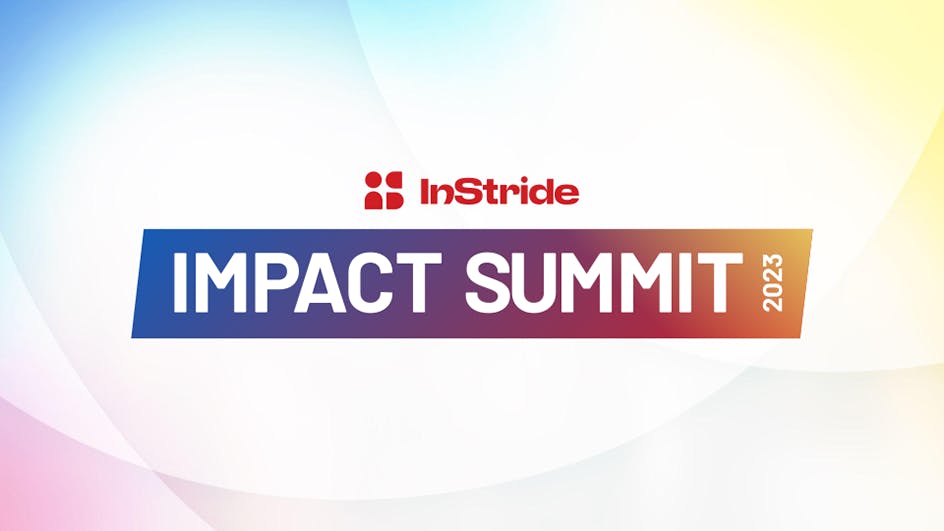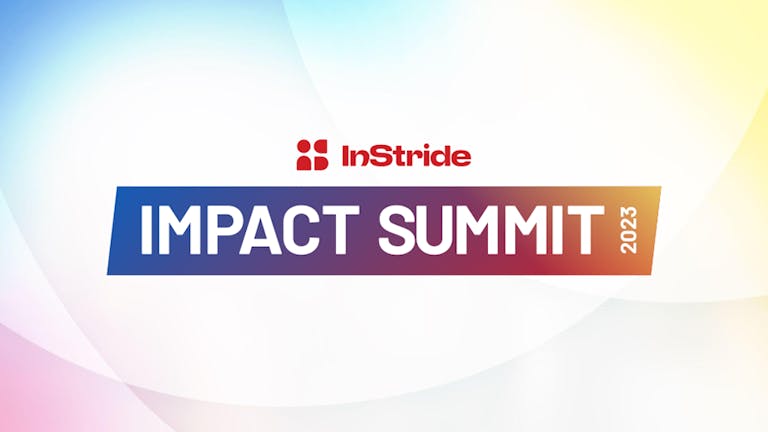The InStride Impact Summit, which took place July 11-12 in Los Angeles, delivered compelling discussions about the bright future of work and education. Following last year’s inaugural event, this year’s Summit united our academic and corporate partners from diverse industries, along with subject matter experts, enabling the exchange of ideas and igniting inspiration.
What was the buzz around the event? We’re glad you asked. Here are three key takeaways you don’t want to miss:
- The power of partnerships: It’s an everyone-wins situation when academic institutions, businesses and their employees collaborate to deliver strategic workforce education.
- Hire for skills, advance with degrees: Skills are critical in hiring, but it’s essential to continue skills development and career growth through strategic learning post-hire.
- From expense to advantage: Data-driven workforce education is the key to up-leveling learning from a cost center to a strategic lever with proven value.
#1 – Collaboration: The key to building the workforce of the future, together
Change is inevitable. And that certainly applies to how workplace learning and skills are being redefined due to digital transformation, AI, human capital trends and more. Not surprisingly, these changes can trigger anxieties, but also unveil opportunities to write new rules and make a more positive impact on the workforce landscape in new and innovative ways.
Looking to find better ways to identify and address changing skills and learning needs, forward-thinking organizations realize they need to co-create this future in partnership with their people and academic institutions.
The employer-employee relationship has to be a two-way street. Today, employees are not only more influential, they are also more demanding of their employers. Alone, organizations can’t solve the challenges in front of them or even find the right challenges to solve, without doing it with their people. It’s a matter of inviting employees to share what they care about, their challenges and ideas for solutions.
On the other hand, partnerships between academic institutions and businesses also have huge potential. Today’s challenges cannot be solved on their own. Nor will lawmakers be able to step in to address higher education challenges such as rising costs, low enrollment and accessibility issues. It’s up to businesses and academic institutions to work together and build the workforce of the future.
Developing an ecosystem mindset is imperative in today’s broader, more connected world. It’s an everyone-wins situation for academic institutions, businesses and their employees when this type of strategic collaboration happens.
#2 – Unlocking potential: The winning combination of skills-based hiring and education
Skills-based hiring is on the rise — and for good reason. The demand for skilled talent is outpacing the supply and the struggle for affordable access to higher education persists. Making skills-first hiring a reality provides a quick win for organizations to source talent from a wider pool and advance workplace diversity, equity and inclusion by opening doors for everyone, including those who have been historically excluded from jobs based on educational background.
At the same time, the significance of degrees and formal learning credentials remain paramount for supporting long-term career growth, lifetime earning potential and addressing the pressing need for upskilling/reskilling in today’s workforce. However, the methods for obtaining these credentials are undergoing a transformation in which a growing number of people are taking non-traditional paths to education, such as earning a degree that is paid for by their employer.
This “outside in - inside up” approach that hires people for skills, then helps them grow internally and advance with continued education delivers true accessibility.
Overall, there is growing recognition across all industries that obtaining employment and degrees are not mutually exclusive endeavors. It’s no longer a matter of choosing between either skills or degrees, but rather embracing the importance of both.
#3 – Elevating workforce education: The data-driven approach
Workforce education has often been viewed as an expense line item on an organization’s profit and loss statement because these programs weren’t built to be measured.
Today, when tasked to do more with less, HR leaders are thinking more strategically about their education investments. This means rethinking traditional approaches, such as tuition assistance and reimbursement, and shifting investment to solutions that drive measurable impact.
Strategic workforce education is a modern, data-driven approach that up-levels learning from a cost center to a strategic lever. This has proven to be a tangible way to produce ROI and make a stronger positive impact on your workforce and business throughout every phase of the employee lifecycle.
Here are some key data points from InStride partners:
- $630+ million in student loan debt prevented, thanks to employer-sponsored programs
- 2x program participation rate over traditional approaches
- 4x reduction in attrition rates
- 3x ROI by reducing costs driven by turnover, recruitment and onboarding
When it comes to measuring the business impact of education, organizations should look at both leading and lagging indicators of success. Leading indicators can be monitored and measured from the beginning, such as participation and enrollment rates. Lagging indicators are “forward-looking” and focus on long-term outcomes such as retention and promotion rates.
InStride works hand-in-hand with our partners to ensure that assessing program performance is a seamless process that fits the unique goals of the business. We also help to continuously analyze the data, derive insights from it and identify optimizations to enable long-term success.
That’s a wrap
The performance and success of an organization hinges on its workforce. So taking a proactive approach to staying ahead of trends within an ever-evolving global landscape is vital. Effective workforce development strategies that nurture a skilled and adaptable workforce enable organizations to navigate challenges, capitalize on opportunities and achieve growth.
To learn more about InStride, connect with us today.

